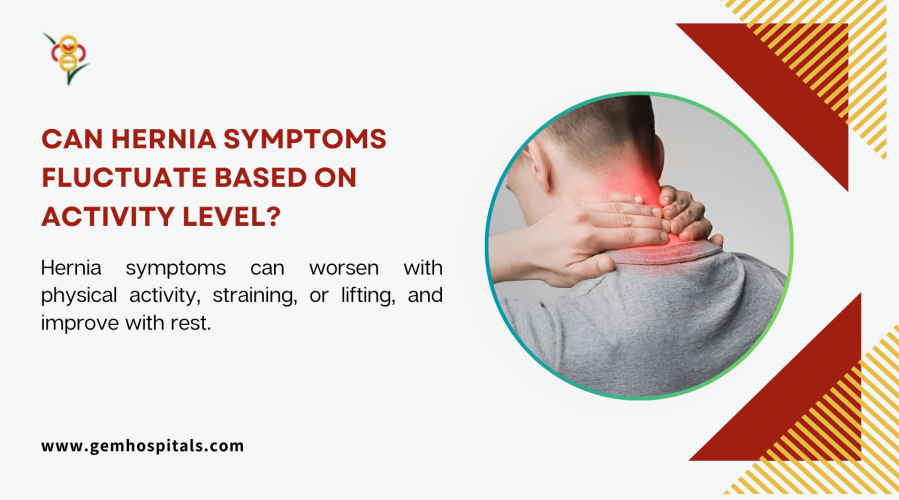Food poisoning is common during the monsoon. Learn when it becomes serious, how it can lead to pancreatitis or liver damage, warning signs, and when to seek medical care.
Can Hernia Symptoms Fluctuate Based on Activity Level?

Hernias are a very common disease that is registered in millions of people in various countries. They are formed when an internal organ or structure herniates through a hole within the muscle or tissue, and the result is pain, discomfort, and a range of other symptoms. Some people have a mild condition and feel moderate pain, while others have a severe condition that affects their quality of life. Notably, hernia signs may change with physical activities, and this has left many people asking how best they can control the symptoms.
This blog post looks more into the relationship between physical activities and the level of pain in hernias with examples of exercises that may exacerbate or help to reduce the pain. We will also provide tips on how to go about it, when to see a doctor and pros of moderate exercise.
Understanding Hernias
A hernia is a condition that arises when an organ or fatty tissue squeezes through a weak area in the muscle or connective tissue. Despite the fact that hernias can occur nearly anywhere in the body, they are most frequently found in the abdominal area, the groin, and above the umbilicus. Some of the most common types include:
- Inguinal Hernia: It is found in the groin and is more common in males than in females. This type of hernia occurs when a piece of the intestine or fat pushes through an opening in the stomach muscles.
- Umbilical Hernia:This type of hernia is found near the navel and may affect babies but can also develop in adults if there is pressure on the abdomen.
- Hiatal Hernia: This is a condition whereby a part of the stomach protrudes through the diaphragm into the chest cavity, and may result in conditions such as acid reflux and heartburn.
- Incisional Hernia: This type of hernia can occur after surgeries since making an incision to the abdominal wall can result in a formation of weak areas in which organs or tissues can bulge through.
Each type of hernia presents unique symptoms and challenges, but they all share one thing in common: that exercise has an effect on the symptoms either making them worse or reduce their occurrence. It is crucial to know how various activities impact your body if you want to treat a hernia properly.
Symptoms of Hernias
Hernias are known to present themselves in different signs and these may be mild or severe and frequent or rare. Here are some of the most common symptoms associated with hernias:
- Visible Bulge: The common symptoms which indicate the presence of a hernia are the presence of a lump on the abdomen, especially when one is standing or pressing on the abdomen.
- Pain or Discomfort: Some individuals with hernias may have pain or discomfort and this may be aggravated by exercise, lifting or straining. Sometimes pain may be a stab like pain and at other times it may be a continuous ache.
- Heaviness or Pressure: A dull, aching, or sore sensation in the abdomen is another of the early signs, which seems to be worse when one moves around or stands for a long time.
- Nausea or Vomiting: In more complicated cases, a hernia can become incarcerated, or the blood supply to the tissue is compromised. This results in nausea, vomiting, and severe pain that should be treated as an emergency.
In many cases, these symptoms may vary depending on the level of physical activity in a particular person. In this way, patients can find out the way in which the hernia is affected by the performed activities and avoid the corresponding actions which cause pain.
How Activity Level Impacts Hernia Symptoms
Hernia symptoms may be mild or severe depending on the movements and activities performed daily. Physical stress and strain vary in degrees and it is important to know how these affect the body to safely treat a hernia.
- High-intensity Activities: Any exertion that involves lifting something heavy, exercising vigorously or using force to an object raises pressure on the abdomen. This pressure can cause stress at the hernia site and in some cases, increase the size of the hernia and or worsen symptoms. For example, weight training, jogging, or any other activity that involves any kind of jerky movement is likely to cause flare-ups and pain.
- Low-impact Exercises: In fact, certain exercises such as walking, swimming and mild stretching exercises can be recommended for patients with hernias. Most of these exercises are less demanding on the abdomen but they tone up muscles and increase flexibility without aggravating the symptoms. The exercises that are most advisable for use by hernia patients are those that are gentle on the body since any pressure on the abdomen may lead to further complications.
- Prolonged Standing or Sitting: Some types of hernias, if not all, may worsen with the individual maintaining a standing or sitting position for long durations. Sitting for a long time puts pressure on the stomach and may worsen symptoms in patients with hiatal or umbilical hernias; standing for long also tires the abdominal region for those with inguinal hernias.
Knowing how various activities affect the presentation of a hernia can help those affected to make the right choices regarding their condition. One has to reduce the activity that causes pain and incorporate gentle motion, which can have a big impact on symptoms.
Tips for Managing Hernia Symptoms Based on Activity Level
In the handling of the symptoms of a hernia, one has to be active but at the same time avoid straining. Here are some tips for managing hernia symptoms based on activity level:
- Avoid Heavy Lifting: One of the most frequent causes of hernia pain and symptoms is lifting heavy objects. In case lifting is inevitable, ensure you use safe methods by bending the knees and holding the object near the body. The twisting movements should be avoided when lifting since they put additional strain.
- Engage in Low-impact Exercises: Some of the best exercises that many patients with hernias should consider include swimming, walking, and yoga. Activities such as swimming are good for the body as they help to bear the body weight thus relieving pressure on the hernia area. Yoga can also be used to perform gentle stretching but certain poses should not be done if they put pressure on the abdomen.
- Wear Supportive Gear:Some people are also able to get a measure of comfort by wearing a belt or hernia truss which holds the hernia in place. But it is recommended to see a doctor before using any supportive equipment because sometimes their improper usage can aggravate the condition.
- Practice Good Posture:Proper sitting, standing, and lifting can also decrease increases in abdominal pressure which are characteristic of a hernia and therefore minimize their occurrence. Sitting or standing with a bent back puts pressure on the hernia region, particularly when one is slouched for a long time.
- Maintain a Healthy Weight: Obesity and overweighting add pressure on the abdomen, and this may lead to the manifestation of a hernia. It is recommended to maintain a proper diet and do light exercises that will not add more pressure on the hernia and help the person to lose some weight.
- Rest When Needed: This is because overexertion is a common cause of an enlargement of the hernia. Listening to your own body cues and knowing when to take a break can help avoid the unnecessary stress. It is also important to take breaks from activity and get some rest in order to control the symptoms properly.
These strategies may be incorporated to help in managing the hernia symptoms hence promote overall health and comfort in the long run.
When to Seek Medical Attention
Some of the symptoms of hernias can be treated by changing some of the habits, but some cases require urgent attention. If you experience any of the following symptoms, contact a healthcare provider promptly:
- Severe Pain or Swelling: Pain at the hernia site increasing or the area becoming swollen is a sign that something is wrong.
- Redness or Tenderness: Swelling or redness in the area of the hernia, and especially if the area is painful, may indicate a problem such as an infection.
- Nausea or Vomiting: Vomiting could be an indication of a strangulated hernia which is a life-threatening condition in which blood supply to the herniated tissue is compromised.
- Difficulty Passing Gas or Bowel Movements: Failure to pass gas or to defecate could be a sign of a bowel blockage, which might develop if the hernia is exerting pressure on the bowel.
These symptoms if diagnosed early can easily be managed and hence no severe complications will arise besides the fact that recovery will be fast.
Suffering from a hernia means that there are certain activities that should be done, and certain activities that should not be done. If you are aware of how you physically move and how it is affecting your hernia, then you can avoid or reduce pain and promote a healthy lifestyle. From walking, jogging and stretching to how to lift an object correctly, these small changes can lead to a big improvement in your health.
To know more about hernia treatments, hernia surgery, and to book an appointment to avail expert consultation, Visit GEM Hospital now. We are here for you to guide you throughout your hernia process with ease and comfort.
Blogs & Article
UTI cases often rise during the rainy season. Learn why urology patients need extra precautions, common causes, symptoms, and prevention tips to stay healthy during monsoon.
Monsoon humidity can worsen endometriosis pain and bloating. Learn how weather changes affect symptoms and discover practical tips to manage discomfort during the rainy season.


